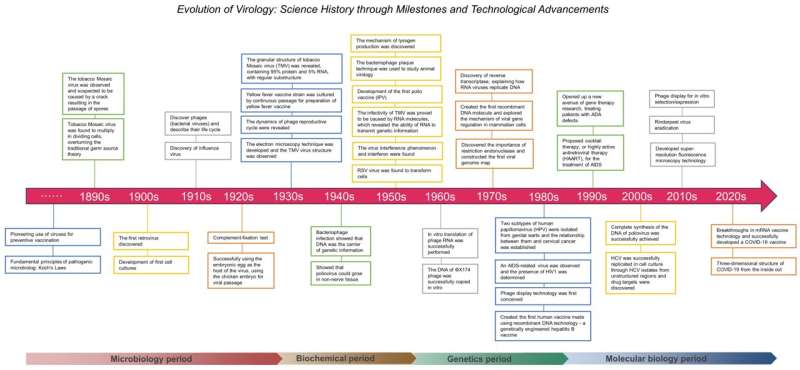This article has been reviewed according to Science X's editorial process and policies. Editors have highlighted the following attributes while ensuring the content's credibility:
fact-checked
proofread
Research team periodizes this history of virology development

A research team led by Associate Professor Liu Huan from the School of Humanities and Social Sciences of University of Science and Technology of China (USTC) proposes for the first time a historical periodization of the development of virology—the periods of microbiology, biochemistry, genetics, and molecular biology—after systematically exploring the evolution of virology and its important milestones and technological achievements. The study is published in Viruses.
By presenting a panoramic view of the development of virology in different historical periods and cognitive environments, researchers revealed the evolutionary characteristics, intrinsic motivations, and external driving forces of virology, as well as the relations and influences among these elements, thus filling a gap in the study of the history of virology.
In this study, although viruses were not directly observed, the concept of viruses was proposed based on experiments such as microbial filtration conducted by Beijerinck, marking the establishment of virology.
In the biochemical period, scientists like Stanley revealed the biological essence of viruses through structural studies of tobacco mosaic virus (TMV). This period also saw a surge of experiments in phage infection and replication, identification of viral proteins and nucleic acids, and innovations in tissue culture techniques.
In the genetic period, virologists revealed the genetic characteristics of viruses, discovered viral RNA infectivity, reverse transcriptase, human papillomavirus, and determined the first viral genome DNA sequence through in-depth studies of the virus life cycle, infection mechanisms, and interactions with host cells.
Since the late 20th century, the development of virology has entered the molecular biology period, where antiviral drugs and genetic engineering technologies have played important roles in the treatment and prevention of viral diseases. Interdisciplinary collaborations between virology and other fields have promoted breakthroughs and developments in advanced biotechnologies such as phage display, immunotherapy, and mRNA vaccines.
Studying the history of virology involves fields such as biology and medicine, and features interdisciplinary integration in natural sciences. It requires delving into the history of virology and exploring the discovery of viruses, vaccine and drug development, and the evolution of diagnostic technologies from a comprehensive historical research perspective.
This research represents an important achievement of the discipline of history of science at USTC in the field of virology history, providing references and reflections for the further development of virology.
More information: Kunlan Zuo et al, Evolution of Virology: Science History through Milestones and Technological Advancements, Viruses (2024). DOI: 10.3390/v16030374


















